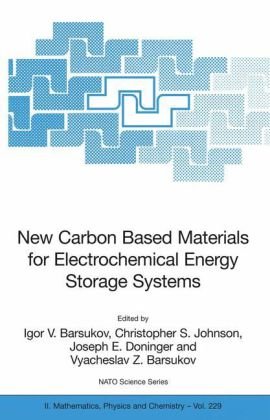

Most ebook files are in PDF format, so you can easily read them using various software such as Foxit Reader or directly on the Google Chrome browser.
Some ebook files are released by publishers in other formats such as .awz, .mobi, .epub, .fb2, etc. You may need to install specific software to read these formats on mobile/PC, such as Calibre.
Please read the tutorial at this link: https://ebookbell.com/faq
We offer FREE conversion to the popular formats you request; however, this may take some time. Therefore, right after payment, please email us, and we will try to provide the service as quickly as possible.
For some exceptional file formats or broken links (if any), please refrain from opening any disputes. Instead, email us first, and we will try to assist within a maximum of 6 hours.
EbookBell Team

0.0
0 reviews
ISBN 13: 9781402048104
Author: Igor V Barsukov, Christopher S Johnson, Joseph E Doninger
Carbonaceous materials play a fundamental role in electrochemical energy storage systems. Carbon in the structural form of graphite is widely used as the active material in lithium-ion batteries; it is abundant, and environmentally friendly. Carbon is also used to conduct and distribute charge effectively throughout composite electrodes of supercapacitors, batteries and fuel cells. The electronic conductive pathways are critical to delivering and extracting current out of the device. However, many challenges and the understanding of the role of carbon and its stability and efficiency in charge storage applications still exists. This NATO-ARW volume contains a diverse collection of papers addressing the role of carbon in some key electrochemical systems, both conventional and emerging. These papers discuss the latest issues associated with development, synthesis, characterization and use of new advanced carbonaceous materials for electrochemical energy storage. Such systems include: metal-air primary and rechargeable batteries, fuel cells, supercapacitors, cathodes and anodes of lithium-ion and lithium polymer rechargeable batteries, as well as nanocarbon materials of the future.
New Carbon Materials for Supercapacitors
Novel Carbonaceous Materials for Application in the Electrochemical Supercapacitors
Effect of Carbonaceous Materials on Performance of Carbon-Carbon and Carbon-Ni Oxide Types of Electrochemical Capacitors with Alkaline Electrolyte
Hybrid Supercapacitors Based on δ-MnO₂/Carbon Nanotubes Composites
Development of Supercapacitors Based on Conducting Polymers
Supercapacitors: Old Problems and New Trends
Modeling Porosity Development During KOH Activation of Coal and Pitch-Derived Carbons for Electrochemical Capacitors
General Properties of Ionic Liquids as Electrolytes for Carbon-Based Double Layer Capacitors
Carbon Materials for Gas Diffusion Electrodes, Metal Air Cells and Batteries
New Concept for the Metal-Air Batteries Using Composites: Conducting Polymers / Expanded Graphite as Catalysts
Mechanically Rechargeable Magnesium-Air Cells with NaCl-Electrolyte
Application of Carbon-Based Materials in Metal-Air Batteries: Research, Development, Commercialization
Metal–Air Batteries with Carbonaceous Air Electrodes and Nonmetallic Catalysts
Carbon Anodes for Lithium-Ion Batteries
Carbonaceous Materials for Batteries
Anode-Electrolyte Reactions in Li Batteries: The Differences Between Graphitic and Metallic Anodes
Performance of Novel Types of Carbonaceous Materials in the Anodes of CLARIO’s Lithium-Ion Battery Systems
Why Graphite Electrodes Fail in PC Solutions: An Insight from Morphological Studies
New Developments in the Advanced Graphite for Lithium-Ion Batteries
Mechanisms of Reversible and Irreversible Insertion in Nanostructured Carbons Used for Li-Ion Batteries
Some Thermodynamics and Kinetics Aspects of the Graphite-Lithium Negative Electrode for Lithium-Ion Batteries
Characterization of Anodes Based on Various Carbonaceous Materials for Application in Lithium-Ion Cells
A Carbon Composite for the Negative Electrode of Li-Ion Batteries
Electrochemical Intercalation of PF⁻₆ and BF⁻₄ into Single-Walled Carbon Nanotubes
Surface Treated Natural Graphite as Anode Material for High-Power Li-Ion Battery Applications
Emerging Metal/Carbon Composite Anodes for Next Generation Lithium-Ion Batteries
On the Theoretical Prerequisites for Application of Novel Materials in Promising Energy Systems
Capabilities of Thin Tin Films as Negative Electrode Active Materials for Lithium-Ion Batteries
Composite Anode Materials for High Energy Density Lithium-Ion Batteries
Electrochemical Activity of Carbons Modified by d-Metal Complexes with Ethanolamines
Metal-Graphite Composites as Materials for Electrodes of Lithium-Ion Batteries
Electrochemical Performance of Ni/Cu-Metallized & Carbon-Coated Graphites for Lithium Batteries
New Nano- Through Macro-Carbons for Energy Systems: Synthesis, Modeling, Characterization
Stabilization of Graphite Nitrate via Co-Intercalation of Organic Compounds
Electrochemical Stability of Natural, Thermally Exfoliated and Modified Forms of Graphite Towards Electrochemical Oxidation
Low Temperature Synthesis of Graphite from Iron Carbide
High Resolution Transmission Electron Microscopy Image Analysis of Disordered Carbons Used for Electrochemical Storage of Energy
Electrolysis of Carbamide-Chloride Melts at Inert Electrodes
Graphite Intercalation as a Way to Carbon-Carbon Composites and Carbon Nanoscrolls
Carbons in the Cathodes of Lithium-Ion Batteries; Alternative Forms of MnO₂, Cathode / Carbon Modeling
Diagnostic Evaluation of Power Fade Phenomena and Calendar Life Reduction in High-Power Lithium-Ion Batteries
Modeling of Electrochemical Processes in the Electrodes Based on Solid Active Reagents and Conductive Carbon Additives
On the Optimal Design of Amorphous Manganese Oxide for Applications in Power Sources
Investigation of Cathodic Materials Based on Different Types of MnO₂/Carbon
Investigation of Thin-Film Electrode Materials as Cathodic Actives for Power Sources
Synthesis of Mixed Oxides Using Polybasic Carboxylic Hydroxy- and Amino-Acid Routes: Problems and Prospects
Improved Electrochemical Properties of Surface-Coated Li(Ni,Co,Mn)O₂ Cathode Material for Li Secondary Batteries
zinc carbon battery electrode
carbon based m
pure carbon materials
what are carbon based materials
types of carbon materials
new carbon materials
new materials for batteries
Tags: Igor V Barsukov, Christopher S Johnson, Joseph E Doninger, Carbon, Materials